Breeding Journal DataSheet for Apogon leptcanthus
General Species:
Apogon leptacanthus Social Structure: schools, and forms temporary pairs for spwaning
Size of Individuals: averaging around 2"
Age of Individuals: unknown (wild caught)
Date added to Tank: 11-25-2005
Broodstock Tank Details Size of Tank: 24 gallon nanocube
Substrate Details: live sand
Filtration Details: stock filtration with Remora C skimmer added
Water Changes: generaly 25% once a week
Water Temperature: typically around 78-80F
Lighting: Metal Halide 150 watt, at some points there was also actinic supplementation, later on changed lighting
Lighting Cycle: generally 12 hours, always on a timer
Other Tank Inhabitants: Too many to mentoin over the years, but noteworth that for a long time, the spawning group of
A. leptacanthus shared their tank with both
Pterapogon kauderni and
Apogon margaritophorus.
Broodstock Feeding Details Food Types: Mostly frozen foods including enriched brine shrimp and mysis, formula 1 and 2 etc...
Feeding Schedule: multiple times per day
Spawning Details Date of First Spawn: 2-3-2006
Spawn Time of Day: 9:30 and 10:45 PM.
Dates of Consecutive Spawns: too many to list. Seems like they can spawn on average twice per month (i.e. every 15-16 days).
Courtship Details: as taken from my original notes -
There's a couple really important behaviors to watch for. The first is the side-by-side twitching which seems to be common amoung all three of the cardinalfish species we've spawned. In this particular case, the female "flicks" her fins much like a Firefish normally does when swimming. There is no discernable "vibrations" (like what you see in Pterapogon kauderii).
The other behavior that is NEW is the "soar" for lack of a better term. I've seen throat bulging, side-by-side twitching, and nudging go on between this pair of fish on numerous occasions. However, I have not seen the "soar". In both videos it occurs towards the end, the female making broad circles out in front of the male.
Egg Size: small (i.e. possibly aorund 1 MM, never was able to measure)
Egg Color: clear?
Egg Count: hundreds
Hatch Details Hatch Date: 2-11-06
Hatch Time of Day: well after lights out
# Days after Spawn: first spawn was hatched after 8 days, although in subsequent spawns sometimes 7. could be related to temperature.
Larve Description: small, but initial measurements put them at possibly as large as 4mm, but subsequent measurements suggest closer to 2.5mm. Fully formed and ready to eat (eyes, mouth, etc..) Picture below.
Larval Tank Details Temperature: 80-82F
Size of Larval Tank: 10 gallon
Substrate Details: none
Other Tank Decor: none
Filtration Details: none
Lighting: standard strip light
Lighting Cycle: probably about 18 hours on, 6 off.
Water Changes: no set routine.
Larval Feeding Details Food Types: rotifers. Baby brine shrimp offered much later in my attempts, perhaps "too late" (around 28 days).
Feeding Schedule: constant (greenwater technique using T-Iso, Nanno and Tet).
Metamorphosis/Settlement Date of Settlement Start: n/a
Days after Hatch: 27
Date of Settlement End: n/a
Description of Fry: at 27 days, the larvae had undergone flexion, that is, the caudal fin was fully developed. On day 28 I noted that the larvae were starting to become more "deep bodied". Largets larvae were around 1 CM (10 MM) at this point. At day 33 a black spot showed on the dorsal fin but wasn't visible in pictures.
Grow-Out Tank Details Temperature: SAME as for larval tank, except greenwater technique was suspended once fish were feeding on baby brine shrimp
Size of Grow-Out Tank: 10
Substrate Details: none
Other Tank Decor: none
Filtration Details: none
Lighting: stock 18" strip light
Lighting Cycle: 18 hours on
Water Changes: as needed.
Size at Transfer: did not transfer
Age at Transfer: N/A
Grow-Out Feeding Details Food Types: Baby Brine Shrimp, Copepods were available
Feeding Schedule: tried to keep food constantly available.
Additional Information Miscellaneous Information:
Ultimately I made it to around 45 days post release with this species. This species HAS been reared to saleable size by ORA and other breeders. Future attempts might have proven successful.
This event was originally documented here on Reef Central -
http://www.reefcentral.co...howthread.php?t=776659 Some pictures: Male holding eggs / larvae: 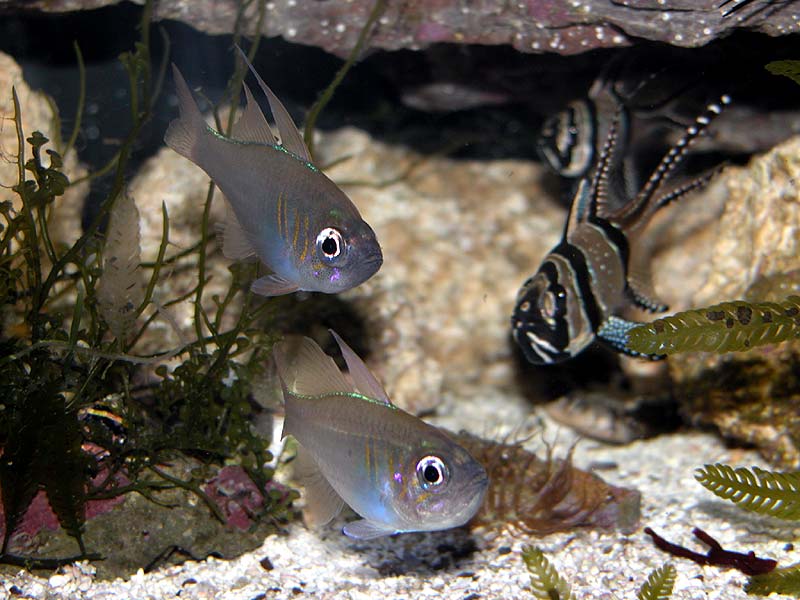
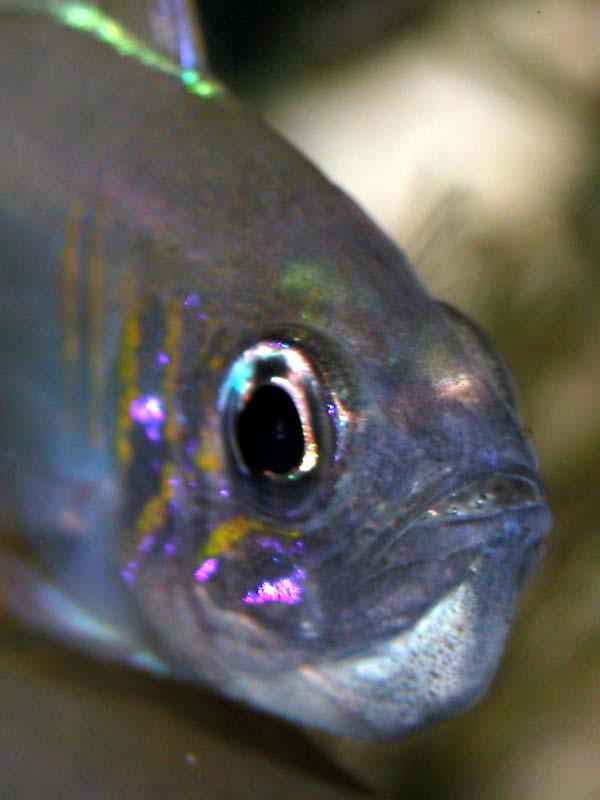 Newly Hatched Apogon leptacanthus at 60X magnification with scale:
Newly Hatched Apogon leptacanthus at 60X magnification with scale: 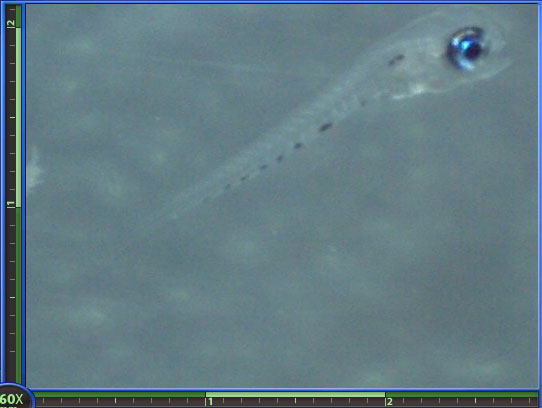 143 hours post release
143 hours post release  192 hours post release, with a 131 hour old Synchiropus splendidus (Mandarin) for comparison
192 hours post release, with a 131 hour old Synchiropus splendidus (Mandarin) for comparison 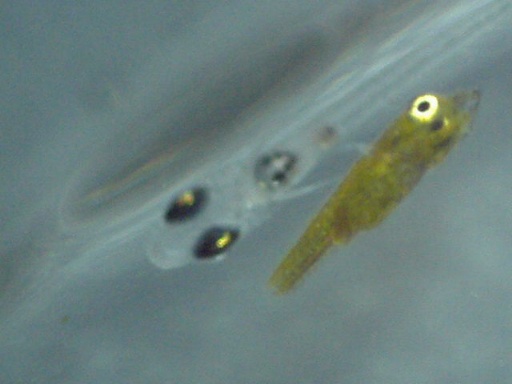 408 hours post release, (17 days) compared to a newly hatched Amphiprion percula at 10X magnification
408 hours post release, (17 days) compared to a newly hatched Amphiprion percula at 10X magnification 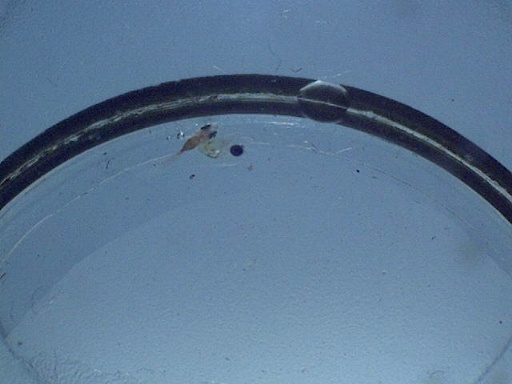 27 days post hatch at 10X magnification, and the larvae have undergone flexion. Some people consider this the occurance of metamorphosis / settlement
27 days post hatch at 10X magnification, and the larvae have undergone flexion. Some people consider this the occurance of metamorphosis / settlement 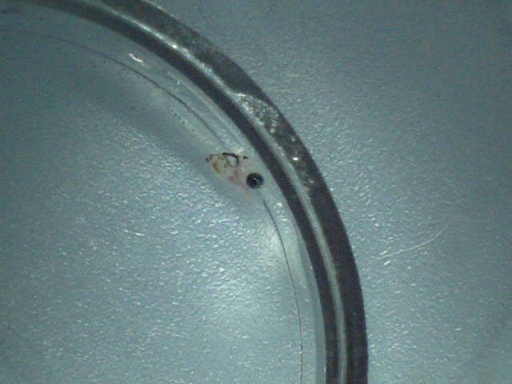 33 days post hatch
33 days post hatch 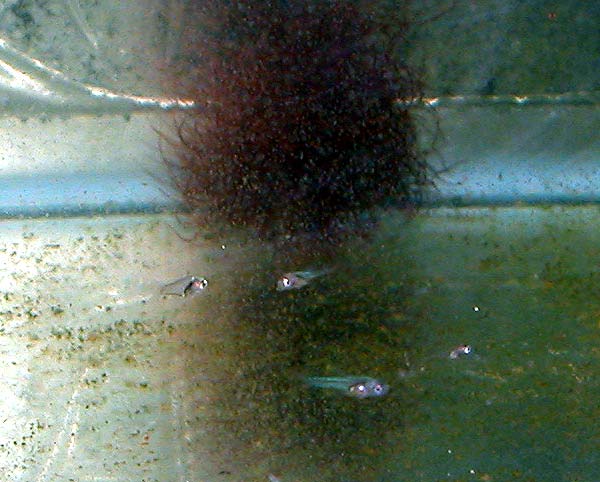
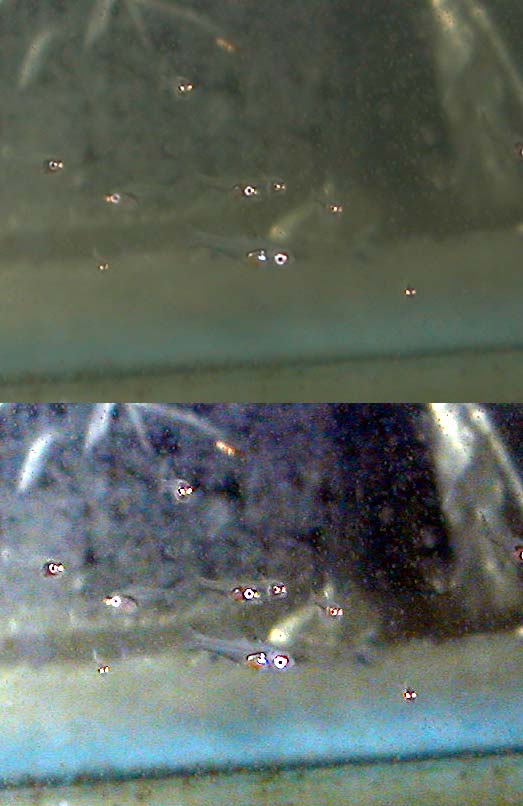 The last two died at 45 days...here's their pictures shortly beforehand, around 1050 hours (43.75 days). Larger one was 1.1 CM
The last two died at 45 days...here's their pictures shortly beforehand, around 1050 hours (43.75 days). Larger one was 1.1 CM 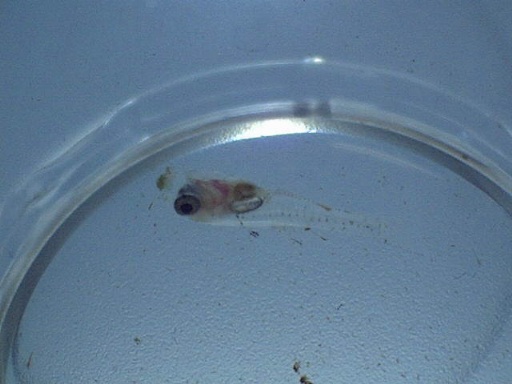
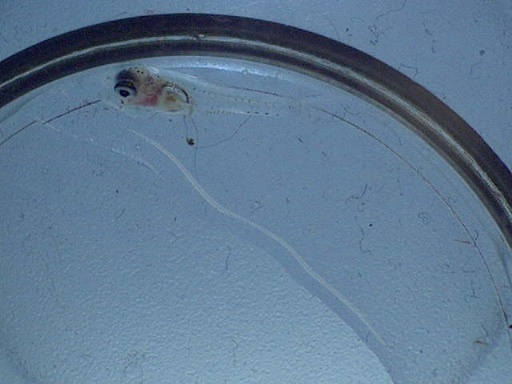
And that's where my work with Apogon leptacanthus ended. Eventually the broodstock stopped spawning and then one by one passed on likely due to burnout or old age...
<message edited by mPedersen on Monday, January 18, 2010 3:41 PM>